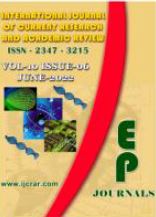Abstract Volume:10 Issue-6 Year-2022 Original Research Articles
 |
Online ISSN : 2347 - 3215 Issues : 12 per year Publisher : Excellent Publishers Email : editorijcret@gmail.com |
Nitrogen is the most yield liming nutrient that can be highly soluble and lost through leaching, volatilization and denitrification. In this view an experiment was conducted to determine the effects of urea stable and convectional urea on crop performance of rice in Pawe district, north western Ethiopia. The experiment was laid out in randomized complete block design with three replications. The treatments were different rate of urea stable and convectional urea applied at planting and in split: (Control, 23 kg N ha-1 from urea stable applied once at planting,23 kg N ha-1 from urea stable in split application, 23 kg N ha-1 from urea stable in split application, 46 kg N ha-1 from urea stable applied once at planting, 46 kg N ha-1 from urea in split application, 69 kg N ha-1 from urea stable in split application, 69 kg N ha-1 from urea in split application, 69 kg N ha-1 from urea stable applied once at planting).The applications of urea stable and conventional urea were significantly improved growth yield and yield components of rice as compared to control. Mean grain yield and biomass yield of rice was significantly affected by nitrogen rate and increased with increasing of nitrogen rate applied from urea stable and conventional urea. Moreover, the mean of over years and over locations result show that the highest biomass yield (11319 kg ha-1) was obtained from 69kg N ha-1 urea stable applied once at planting, whereas the lowest biomass yield (7630 kg ha-1) was recorded in negative control treatment Applications of 69 kg N ha-1 from urea stable fertilizer applied at planting, 69 kg N ha-1 from conventional urea fertilizer applied in split and 69 kg N ha-1 from urea stable fertilizer applied in split in increased the grain yield by 49.3, 49 and 45 % over the negative control, respectively but statistically similar from application of 46 kg N ha-1 applied in split in the form of conventional urea (+ve control) and 46 kg N ha-1 from urea stable fertilizer applied at planting. Therefore, there was no evidence in our research that supports the advantage of urea stable over the conventional urea. Hence it is concluded that the application N fertilizers sources from both of urea and urea-stable are equal result obtained in improving of rice productivity.
How to cite this article:
Mesfin Kuma, Getachew Yilma, Wubayehu Gebra Medini and Mamo Bekele. 2022. Evaluate Performance of Rice Crop through Application of Urea Stable and Conventional Urea in Pawe District, North Western Ethiopia.Int.J.Curr.Res.Aca.Rev. 10(6): 119-125doi: https://doi.org/10.20546/ijcrar.2022.1006.011



Quick Navigation
- Print Article
- Full Text PDF
- How to Cite this Article
- on Google
- on Google Scholor
- Citation Alert By Google Scholar
